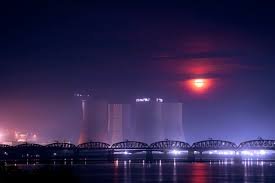
Rooppur nuclear power plant is a prestigious project of Bangladesh, which has become a member of the elite club of nuclear electricity producers. The plant is situated at Ishwardi in the district of Pabna, on the river Padma, which flows lean in the dry season and is full and turbulent in the Monsoon. The plant consists of two units, each with a 1,200 MW Russian reactor model VVER-1200, for a total capacity of 2,400 MW. Both units are under construction, and one of them has started pre-commissioning tests. It is a turnkey project under Russian credit, and ROSATOM, a state-owned company of Russia, is taking care of the design, supply, installation, and commissioning.
The VVER-1200 model has been designed for cold countries like Russia, where cooling water below 20°C is naturally available at sea, lakes, and rivers. The nominal capacity of 1,200 MW is based on cold weather conditions. Bangladesh is a hot country, and so the capacity will be reduced.
Effect of hot weather in Bangladesh
The ambient temperature in Ishwardi reaches 40°C during the peak summer. The river water temperature also becomes very hot. The cooling water temperature after evaporative cooling in cooling towers will be 32°C, and that at the condenser inlet will be 33°C, which is 15°C higher than the design temperature of 18°C. As a result, the turbine will miss the output involved in this 15-degree range. The plant will not be able to reach the nominal capacity. A research paper states that capacity will decrease by 0.444% for a 1-degree increase in water temperature. Thus, for hot weather, each unit of the Rooppur power plant will be de-rated by about 80 MW.
Borrowing of electricity from the national grid
Unlike conventional nuclear power plants, the VVER-1200 cannot drive its auxiliaries by bleeding its own steam. It has to borrow electricity from an external source. There are huge water pumps and powerful motor-driven valves in the primary and secondary loops. Additionally, the circuit contains numerous control unit assembly drives, ventilation units, and pumps, all of which require electrical power. To run auxiliary drives, the plant will draw 120 MW from the grid, and the generated power will be adjusted accordingly.
Power required for electric pre-heaters
There are many pre-heaters in water and steam circuits. They are all electric heaters instead of their own steam-heated heaters. They will require huge amounts of electrical power, which will also come from an external source. The power requirement will be around 10 MW.
Power required by the fans of cooling towers
The Rooppur power plant will utilize forced draft cooling towers to enhance evaporative cooling, producing cold water for the steam condenser. High-power draft fans are installed around the perimeter of the towers at the base. The fans are an additional requirement for a plant in a cold country.
The fans will require approximately 12 MW of electrical power (0.1% of the nominal capacity), which the national grid will also supply.
Summation
Rooppur power plant with a total capacity of 2,400 MW will be de-rated to about 1,960 MW (for hot weather, 160 MW, and for refund of borrowed electricity, 280 MW). It will not be a surprise if the plant's average output drops to 1,500 MW. The situation will be a disappointment as the original levelized cost of electricity (LCOE) will no longer be valid. The cost recovery plan of the project will be in jeopardy.
Conclusion
The VVER-1200, a high-capacity plant, faces a substantial reduction in capacity and is not cost-effective for Bangladesh. Smaller plants, with a nominal capacity of around 500 MW that reject steam at temperatures above 50°C, will be a better choice for Bangladesh's future expansion program, if any. In that case, the steam can be condensed using naturally available water from a river or sea. The plants shall be able to bleed steam to power the auxiliary drives, rather than relying on an external source for power.
K.M. Mahbubur Rahman, Senior Mechanical Engineer
Downloan Opinion As PDF/userfiles/EP_23_07_Opinion.pdf



